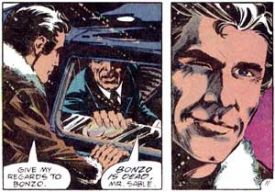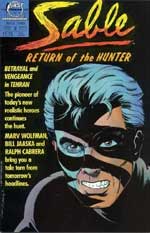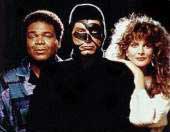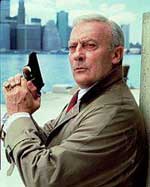The Cold War Gets Even Colder
By Philip Schweier
March 10, 2008 - 07:18
"Remember the good old 1980s,
When things were so uncomplicated..."
– From “Ticket to the Moon,” off the ELO album Time
Or, as it was said in 1997's The Peacemaker, "God, I miss the Cold War." For decades, the Cold War was a standoff between NATO and the former Soviet Union. There were occasional flare-ups, such as the Cuban Missile Crisis of 1962 and the Viet Nam conflict. Nevertheless, we knew who our enemies were, and good and evil were slightly more black and white.
By the mid-1970s, America's attention was drawn elsewhere, such as the Middle East, and the world began to change. With the advent of the Ronald Reagan administration came detente, and the Iron Curtain began to rust away. Allies became enemies and enemies became allies. The post disco era of 1980 gave way to New Wave.
In fiction, the aggressive stance America had taken with the Soviet Union began to soften, and diehard communists became fodder for villainous roles in such movies as James Bond's Octopussy. Super-spies on this side of the Atlantic were put out to pasture in one form or another.
 |
Jon Sable, Freelance, ran for 56 issues, after which Grell stepped aside to work on Green Arrow: The Longbow Hunters for DC Comics. The series was re-launched, written by Marv Wolfman. This coincided with the development of a TV adaptation featuring Lewis Van Bergen in the title role and future star Rene Russo as his literary agent Eden Kendall.
 |
 |
By 1988, the "man with a gun" shows, as my college roommate called them, had run their course on American television. They were usually centered around a deadly serious private detective/mercenary of some sort. Perhaps the genre was spawned by the stylish Miami Vice. Producer Michael Mann would create a follow-up with 1986's Crime Story. Set in early 1960s Chicago, the series was a stylish blend of Miami Vice and The Untouchables.
Other series in the genre suffered turbulent production spells. Spenser for Hire, based on Robert B. Parker's mystery novels, dealt with cast changes as co-star Barbara Stock left, only to return a season later. Hawk, a supporting character played by Avery Brooks, was spun off on his own series in 1989, but it lasted only 13 episodes.
Meanwhile, Stacy Keach, star of Mickey Spillane's Mike Hammer, served six months for possession when cocaine was found hidden in a can of shaving cream as he passed through London's Heathrow airport. When the show returned from hiatus, much of the light-hearted humor was gone and the show took on a grittier feel, keeping with Spillane's original character. Now shot in Manhattan rather than a Hollywood backlot, busty women were no longer throwing themselves at the private eye.
 |
Production was disrupted when Woodward suffered a heart attack in the summer of 1987. During his recuperation, Robert Mitchum was brought on as a former colleague, helping McCall's son search for his missing father in the two-part episode, "Mission: McCall." Later, Richard Jordan joined the cast as embittered former operative Harley Gage and stayed for eight more episodes.
Jon Sable returned for a guest appearance in another Mike Grell comic, Shaman's Tears, from Image Comics in the mid-'90s, as well as a novel in 2000. On the dustjacket, long-time fan Gene Simmons of KISS is quoted as saying, "Jon Sable – big game hunter in the concrete jungle – I wish I was him." Shortly afterward it was announced that Simmons had optioned the character for film, but plans for the movie were derailed in the wake of the terrorist attacks of September 11, 2001.
In 2005, collected volumes reprinting the original Sable material from First Comics, as well as a new limited series, were released by IDW. Comicmix.com is currently publishing a brand new Jon Sable story online, though the pages can't be posted fast enough to suit me.
Since Sable's return to comics, Grell has backtracked on the character's background. When he debuted in 1983, he was a veteran of Viet Nam, the 1972 Olympics and the war in Rhodesia. Today, like most comic book characters, Sable has remained ageless as the world around him has evolved. I personally would've preferred if Sable had remained a staple of the 1980s, much like Sherlock Holmes is perpetually set in the 1890s. Such characters are products of their time, and therein lies part of their appeal. We have fond memories of what their era may have been like, and how they related to their world and ourselves.
The 1980s represent a bridge between the good old-fashioned legwork of tough guys like Mickey Spillane and the increasingly high-tech toys of James Bond. This was an era before cell phones and Internet. Some heroes got further with the direct approach of a bullet to the knee than the subtle tactic of cyber-burglary. That's one of the things I like about Jack Bauer so much.
Nevertheless, I'm willing to go out on a limb and suggest that in 2008, things have improved in many ways. In the comic book world, the writing is more sophisticated than ever, and on film, special effects are about as realistic as it gets. Computers and micro-technology have opened up an entire new world of design possibilities in everything ranging from architecture and urban planning to product design and packaging. Health care has advanced at a staggering rate and communication to the even the most remote and untouched areas of the world is as simple as picking up a phone.
So despite all this advancement, what is it about the 1980s that has such appeal? Perhaps it's the optimism. As a song from the era said, "The future's so bright, I gotta wear shades." Every 20 years or so, the cycle repeats itself. With the close of World War II, America seemed unstoppable. John F. Kennedy, in promising the nation the moon, called upon people everywhere to be pioneers in the new frontier. However, under the glow of that moonlight, came racial strife, a divisive war, corruption at the highest level and what some people regard as a softened America.
While former actor Ronald Reagan might not have been everyone's favorite president, he proved to be an effective communicator, thereby ushering another period of optimism. Dressed in Western wear reminiscent of our nation's heritage, he helped instill a certain amount of pride in being an American, though many other aspects of his administration remain in doubt.
With political wannabes jockeying for position for a shot at the White House, and a turbulent economic road ahead, that same optimism lies before us again, if we only chose to pick it up and wield it as weapon against pessimism and negativity. Therein lie the true villains, with no shades of gray whatsoever.
Praise and adulation? Scorn and ridicule? E-mail me at philip@comicookbin.com.
Related Articles:
Man of Steel: Reusable Sticker Book
Sable and Azaceta Return to Image with "Graveyard of Empires"
Mike Grell on The Return of Jon Sable
